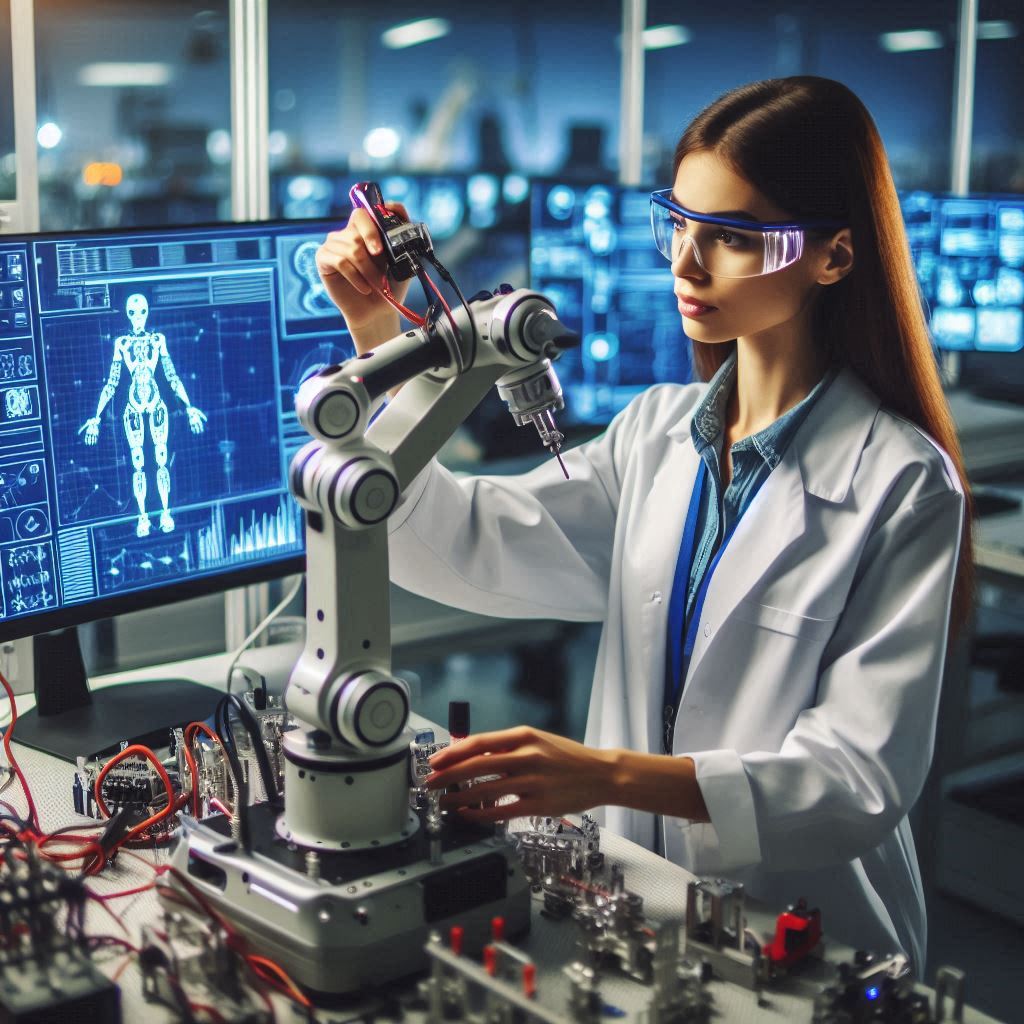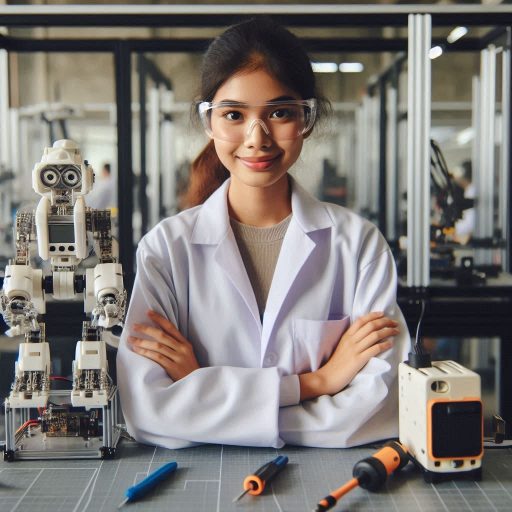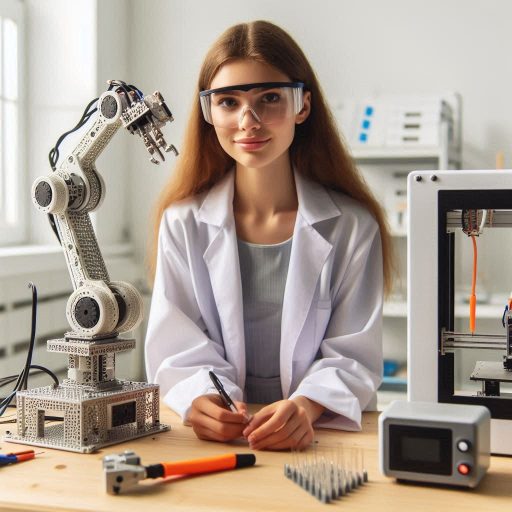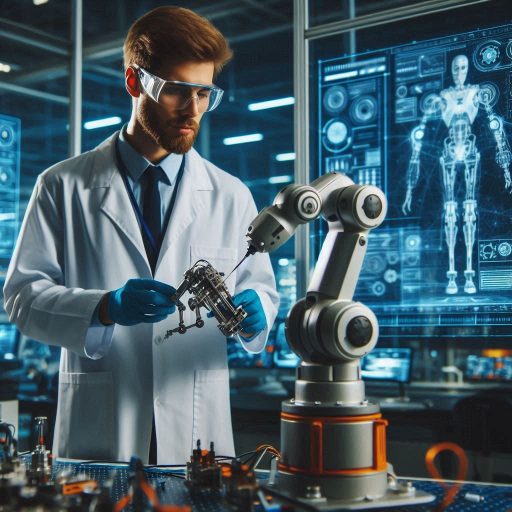Introduction
The evolution of robotics has been remarkable over recent decades.
Initially, robots were designed to perform basic, repetitive tasks with limited functionality.
Today, however, robotics technology has advanced significantly, enabling machines to handle increasingly complex operations.
This evolution reflects the growing importance and versatility of robotics across various industries.
They manage intricate tasks that were once challenging for human workers, leading to higher quality products and reduced production costs.
In healthcare, robotics technology enhances surgical precision and supports patient care, contributing to better medical outcomes and streamlined operations.
In agriculture, robots assist with tasks such as planting, harvesting, and monitoring crops, which improves productivity and optimizes resource use.
Understanding these predictions is vital for preparing for the future of robotics.
As technology continues to advance, it will reshape industries and create new opportunities.
By staying informed about these trends, businesses and professionals can better navigate the evolving landscape and harness the full potential of robotics technology.
Current State of Robotics
How Robots Are Currently Used
Robots are transforming numerous industries with their diverse applications.
They handle repetitive and hazardous tasks, enhancing efficiency and safety.
In manufacturing, robots automate assembly lines, perform welding, and handle material transport.
In healthcare, robots assist in surgeries, provide patient care, and help in rehabilitation.
Robots also find use in agriculture, performing tasks such as planting, harvesting, and monitoring crops.
They are employed in logistics for sorting packages and managing warehouse inventories.
Additionally, robots are increasingly used in consumer applications, such as household cleaning and personal assistance.
Industries Utilizing Robotics Technology
- Manufacturing: Robots are extensively used in automotive assembly, electronics, and consumer goods production.
They improve precision and speed in manufacturing processes. - Healthcare: In healthcare, robots assist in minimally invasive surgeries, automate diagnostics, and support elderly care.
They enhance surgical accuracy and patient recovery. - Agriculture: Robotics technology is revolutionizing agriculture with autonomous tractors, drones for crop monitoring, and robots for planting and harvesting.
- Logistics: Robots streamline logistics by automating sorting, packing, and inventory management in warehouses and distribution centers.
- Consumer Services: Robots are increasingly common in household tasks, such as vacuuming and lawn mowing, offering convenience and efficiency.
Statistics on Robotics Industry Growth
The robotics industry is experiencing rapid growth.
According to recent data, the global robotics market is projected to reach $80 billion by 2025.
The manufacturing sector leads this growth, accounting for the largest share of robotics investments.
The healthcare robotics market is also expanding, with a growth rate expected to exceed 20% annually in the coming years.
Agricultural robotics is emerging as a significant growth area, driven by the need for increased efficiency and productivity in food production.
In closing, robotics technology is making significant strides across various industries.
From enhancing manufacturing processes to revolutionizing healthcare and agriculture, robots are becoming integral to modern operations.
The impressive growth statistics underscore the increasing adoption and impact of robotics, highlighting their pivotal role in shaping the future of multiple sectors.
As technology advances, the potential applications and benefits of robotics will continue to expand, driving further innovation and efficiency across industries.
Read: How to Build a Strong CAD Technician Portfolio
Predictions for advancements in AI
Speculation on AI Development in Robotics
Artificial Intelligence (AI) is set to revolutionize robotics in the coming years.
Experts predict rapid advancements in AI algorithms and technologies.
These improvements will enhance robots’ cognitive abilities, making them smarter and more adaptive.
AI will drive the development of robots capable of complex problem-solving and decision-making.
This evolution will enable robots to perform tasks with greater efficiency and accuracy.
Enhanced AI will also lead to more intuitive human-robot interactions, allowing for smoother collaboration between humans and machines.
Implications of AI on Robotic Capabilities
AI advancements will significantly expand robotic capabilities.
Robots will become more autonomous, with AI enabling them to learn and adapt from their environments.
Enhanced machine learning algorithms will improve robots‘ ability to perform a wider range of tasks.
AI will facilitate more sophisticated sensory perception, allowing robots to understand and respond to complex stimuli.
This progress will lead to robots that can navigate unpredictable environments, such as homes and workplaces, with ease.
Additionally, AI will improve robots’ problem-solving skills, enabling them to tackle tasks that require critical thinking and adaptability.
Forecasts for AI Integration in Everyday Robotics
The integration of AI into everyday robotics applications will transform various aspects of daily life.
In domestic settings, AI-powered robots will assist with household chores, such as cleaning and cooking.
These robots will be able to understand and anticipate user needs, making them more useful and efficient.
In healthcare, AI-integrated robots will support patient care by providing personalized assistance and monitoring health conditions.
The advancements will also extend to workplaces, where AI-driven robots will perform tasks ranging from assembly line operations to complex logistical support.
The rise of AI will foster smarter, more capable robots in various sectors.
For instance, in agriculture, AI robots will optimize crop management through precise monitoring and automated interventions.
In transportation, AI will enhance autonomous vehicles’ safety and efficiency, leading to more reliable and accessible transportation options.
As AI continues to advance, the potential applications of robotics will expand, offering new solutions to everyday challenges.
The integration of AI will make robots more versatile and effective, driving innovation across multiple industries.
By leveraging AI advancements, robotics will play an increasingly prominent role in enhancing productivity, improving quality of life, and solving complex problems.
Lastly, the future of robotics will be shaped by rapid advancements in AI.
These developments will enhance robotic capabilities, leading to smarter and more adaptable machines.
The integration of AI will transform everyday applications, making robots more useful and efficient in various aspects of life.
Read: Best Online Courses for CAD Technician Training
Impact of Robotics on Employment
Potential Displacement of Human Workers
The rise of robotics brings both opportunities and challenges to the job market.
One significant concern is the potential displacement of human workers by robots.
As automation technology advances, robots are increasingly capable of performing tasks traditionally done by people.
This includes roles in manufacturing, logistics, and even service industries.
Robots can operate around the clock without breaks, leading companies to favor automation for cost efficiency and productivity.
Consequently, this shift may lead to job losses in sectors heavily reliant on manual labor.
Creation of New Job Opportunities
Despite concerns about job displacement, robotics also creates new employment opportunities.
The development, maintenance, and programming of robots require skilled professionals.
This leads to demand for jobs in robotics engineering, software development, and technical support.
Additionally, as robots take over repetitive or hazardous tasks, new roles emerge in areas like robotics integration, system analysis, and user training.
The growth of robotics technology spurs innovation in various industries, leading to new business ventures and job sectors previously unimagined.
Human-Robot Collaboration
Looking ahead, the future will likely see increased collaboration between humans and robots.
Rather than replacing human workers entirely, robots will augment human capabilities and improve efficiency.
For instance, robots can handle dangerous or monotonous tasks, allowing humans to focus on more complex and creative aspects of their work.
This synergy can lead to enhanced productivity and job satisfaction.
Human oversight remains crucial, ensuring that robots function correctly and adapt to new challenges.
By integrating robots into the workforce, businesses can leverage the strengths of both humans and machines.
Read: Top Companies Hiring CAD Technicians in the USA

Predictions for Robotics in Healthcare industry
Revolutionizing Healthcare Delivery
The future of robotics promises to transform healthcare delivery significantly.
Robotics will enhance precision, efficiency, and accessibility in medical care.
Industry experts forecast that robotic technologies will streamline procedures, reduce human error, and improve patient outcomes.
As these advancements unfold, we can expect more personalized and efficient treatment options.
Robotic systems will increasingly support doctors in diagnosing, treating, and managing various health conditions.
The integration of robotics in healthcare will make complex procedures safer and more reliable.
Current Robotic Technologies in Healthcare
Several robotic technologies are already making an impact in the healthcare industry:
- Surgical Robots: These robots, like the da Vinci Surgical System, enable minimally invasive surgeries.
They enhance precision and control, leading to quicker recovery times and less risk of complications. - Rehabilitation Robots: Devices such as exoskeletons assist patients in regaining mobility and strength.
These robots aid in physical therapy and rehabilitation, offering tailored exercises and support. - Robotic Prosthetics: Advanced prosthetic limbs equipped with robotics offer enhanced functionality and control.
They improve the quality of life for amputees by providing more natural movement and adaptability. - Telepresence Robots: These robots facilitate remote consultations and monitoring.
They bridge gaps in healthcare access, allowing specialists to provide care regardless of geographical constraints.
Speculations on Future Advancements
Looking ahead, several exciting advancements are expected in robotic surgery and patient care:
- Enhanced Surgical Precision: Future surgical robots will feature even greater precision and dexterity.
They will integrate advanced imaging technologies and AI to assist surgeons with complex procedures. - Autonomous Surgical Robots: We may see robots capable of performing surgeries with minimal human intervention.
These robots will use real-time data to make decisions and adjust techniques as needed. - Smart Diagnostic Robots: Future robots will have advanced diagnostic capabilities.
They will analyze patient data, predict health issues, and suggest treatments based on comprehensive analysis. - Robotic Caregivers: Robots designed to assist in daily living activities will become more sophisticated.
They will offer support in elderly care and provide companionship, improving the quality of life for seniors. - Advanced Rehabilitation Devices: New rehabilitation robots will incorporate AI to adapt exercises and therapies in real-time.
They will tailor treatments to individual progress, enhancing recovery outcomes.
The future of robotics in healthcare is promising and full of potential.
As technology evolves, robots will play an increasingly central role in improving medical procedures and patient care.
By advancing surgical techniques and patient management, robotics will revolutionize how healthcare is delivered.
Embracing these innovations will lead to more effective, efficient, and personalized medical care.
Read: Future of CAD Technician Jobs in Engineering
Ethics and Regulations in Robotics
Ethical Implications of Advanced Robotics
As robotics technology advances, ethical considerations become increasingly important.
Advanced robotics raises several ethical concerns, including privacy, autonomy, and decision-making.
For instance, robots equipped with AI can make decisions that affect human lives.
This capability necessitates a discussion on how to ensure these decisions align with ethical standards.
Another concern is the impact of robotics on employment.
Automation can lead to job displacement, affecting workers’ livelihoods.
It is crucial to consider how to balance technological progress with social responsibility.
Additionally, robots used in surveillance or military applications present significant ethical dilemmas.
Ensuring these technologies are used responsibly is vital to addressing public concerns.
Need for Regulations
With the rapid development of robotic technology, the need for regulations becomes clear.
Regulations are essential to ensure robotics technology is developed and used responsibly.
They help set standards for safety, privacy, and ethical practices.
Regulatory frameworks can address issues like the misuse of robots for harmful purposes or the creation of autonomous systems that lack accountability.
Without regulations, there is a risk of technology outpacing ethical considerations and societal norms.
Establishing guidelines for the development, deployment, and monitoring of robotic systems is crucial for managing risks and ensuring ethical compliance.
Predictions on Addressing Ethical Issues
Looking forward, society will likely adopt several approaches to address ethical issues in robotics.
Governments and regulatory bodies will play a key role in shaping policies and guidelines.
Expect increased collaboration between technology developers, ethicists, and policymakers to create comprehensive regulatory frameworks.
International standards and agreements may emerge to address global concerns related to robotics and AI.
Moreover, educational initiatives will become essential for raising awareness about the ethical use of robotics.
Training programs for engineers and developers will include ethics as a core component.
Public dialogue will also be crucial in shaping the direction of robotics ethics.
Engaging diverse stakeholders will help ensure that various perspectives are considered and addressed.
In the end, the ethical implications of advanced robotics require careful consideration and proactive measures.
Regulations are necessary to govern the development and use of robotic technology, ensuring it aligns with societal values and ethical standards.
As robotics continues to evolve, society will need to adopt comprehensive approaches to address these ethical challenges.
By fostering collaboration, establishing clear guidelines, and promoting public awareness, we can navigate the complex landscape of robotics and ensure its positive impact on society.
Transform Your Career Today
Unlock a personalized career strategy that drives real results. Get tailored advice and a roadmap designed just for you.
Start NowFind Out More: Importance of Math in Computer Engineering
Predictions for Consumer Robotics
Impact on Everyday Consumer Products
Robotics is set to transform various consumer products.
Experts predict that robots will become more integrated into household items, making them more autonomous and interactive.
Innovations in robotics will likely lead to smarter home appliances, personal assistants, and even robotic pets.
These advancements aim to improve convenience, efficiency, and overall quality of life for users.
Current Examples of Consumer Robotics
Several consumer robotics products are already on the market, showcasing the technology’s potential. Here are a few notable examples:
- Robotic Vacuums: Devices like the Roomba autonomously clean floors, navigating around obstacles and adjusting to different surfaces.
- Smart Home Assistants: Products such as Amazon Echo and Google Home integrate voice recognition and automation to manage smart home devices.
- Personal Robots: Companion robots like the Jibo offer social interaction and assistance with daily tasks, including reminders and entertainment.
Future Forecasts for Robotics in Households
Looking ahead, experts predict several trends for robotics in households:
- Increased Automation: Future home robots will handle more complex tasks, from cooking and cleaning to managing household inventories.
- Enhanced Personalization: Robots will offer tailored experiences based on user preferences and behavior, making interactions more intuitive and effective.
- Improved Integration: Consumer robotics will seamlessly integrate with other smart home devices, creating a more interconnected and efficient home environment.
- Affordable and Accessible: As technology advances, the cost of robotics will decrease, making them more accessible to a broader range of consumers.
Predictions for Personal Devices
Personal robotics devices will become increasingly sophisticated.
Wearable robots, like exoskeletons, will assist with mobility and physical tasks.
Personal healthcare robots will monitor health metrics and provide medical assistance.
Additionally, personal robots will enhance entertainment and education, offering interactive and engaging experiences.
In general, the future of consumer robotics holds exciting possibilities.
Predictions suggest that robotics will deeply influence everyday products and personal devices, making life more convenient and connected.
With ongoing advancements, we can expect a surge in innovative consumer robotics products, transforming how we interact with technology in our homes.
The journey towards a more robotic-enhanced lifestyle is just beginning, and the impact on everyday living promises to be profound.
Uncover the Details: Transportation Engineering Internships: What to Expect
Challenges and obstacles in advancing robotics
Current Barriers to Innovation
Several barriers currently impede the advancement of robotics. These challenges include:
- Technical Limitations: Existing technology often limits the capabilities of robots.
Enhancing sensors, actuators, and AI algorithms remains a major challenge. - High Costs: Developing advanced robotic systems requires substantial financial investment.
High costs of materials and technology can be prohibitive for many companies. - Integration Difficulties: Integrating robots into existing systems can be complex.
Compatibility issues and the need for customized solutions slow down progress. - Safety and Reliability: Ensuring that robots operate safely and reliably in various environments is critical.
Issues with system failures and safety protocols need addressing. - Ethical and Social Concerns: As robots become more autonomous, ethical questions arise.
Concerns about job displacement and privacy need to be managed carefully.
Predictions on Overcoming Challenges
Industry experts predict several approaches to overcoming these obstacles:
- Advancements in AI and Machine Learning: Enhanced AI algorithms will improve robot capabilities and autonomy.
Better machine learning techniques will enable robots to learn and adapt more effectively. - Cost Reduction through Innovation: Innovations in manufacturing processes and materials will help reduce costs.
Economies of scale and improved efficiency will make advanced robotics more affordable. - Improved Integration Technologies: New standards and technologies will simplify the integration of robots.
Modular designs and interoperability solutions will facilitate smoother adoption. - Enhanced Safety Protocols: Development of advanced safety systems and redundancy measures will increase reliability.
Rigorous testing and validation will ensure robots operate safely. - Addressing Ethical Concerns: Ongoing dialogue and regulations will address ethical and social issues.
Ensuring transparency and fairness will be crucial in integrating robots into society.
Role of Research and Development
Research and development (R&D) play a pivotal role in overcoming these challenges. R&D efforts focus on several key areas:
- Innovation in Technology: R&D drives technological advancements in robotics.
This includes developing better sensors, actuators, and AI systems. - Testing and Prototyping: Rigorous testing and prototyping help refine robotic systems.
This process ensures that new technologies are reliable and effective. - Collaboration and Knowledge Sharing: Collaborative efforts among researchers, industry professionals, and academic institutions accelerate progress.
Sharing knowledge and resources fosters innovation. - Addressing Ethical Issues: R&D also explores ethical implications and societal impacts.
This ensures that robots are developed with consideration for ethical standards and social acceptance.
Generally, while challenges in advancing robotics are significant, industry experts are actively working to overcome them.
Through advancements in technology, cost reduction, improved integration, and addressing ethical concerns, the field is set to progress.
Research and development remain central to pushing the boundaries of robotics and driving future innovations.
Conclusion
Industry experts offer intriguing predictions about the future of robotics.
They envision significant advancements driven by artificial intelligence, leading to smarter and more autonomous robots.
These advancements will enhance human-robot collaboration, making robots more integrated and effective in various industries, including healthcare, manufacturing, and everyday life.
For instance, robots are expected to revolutionize surgical procedures with precision and efficiency while streamlining production processes in factories.
The potential benefits of these advancements are substantial.
Robotics could lead to unprecedented levels of efficiency, accuracy, and innovation.
In healthcare, robots may assist with complex surgeries, provide support for the elderly, and even revolutionize patient care.
In manufacturing, robots could optimize production lines and improve product quality.
Daily life might become more convenient with robots handling routine tasks and enhancing home automation.
However, this future is not without its challenges.
Additionally, there will be challenges related to ensuring the safe and ethical use of robots in various applications.
[E-Books for Sale]
The Big Book of 500 High-Paying Jobs in America: Unlock Your Earning Potential
$19.99 • 500 High-Paying Jobs • 330 pages
Explore 500 high-paying jobs in America and learn how to boost your career, earn more, and achieve success!
See All 500 High-Paying Jobs of this E-Book
1001 Professions Without a Degree: High-Paying American Jobs You Can Start Now
$19.99 • 1001 Professions Without a Degree • 174 pages
Discover 1001 high-paying jobs without a degree! Unlock career tips, skills, and success strategies for just $19.99!




